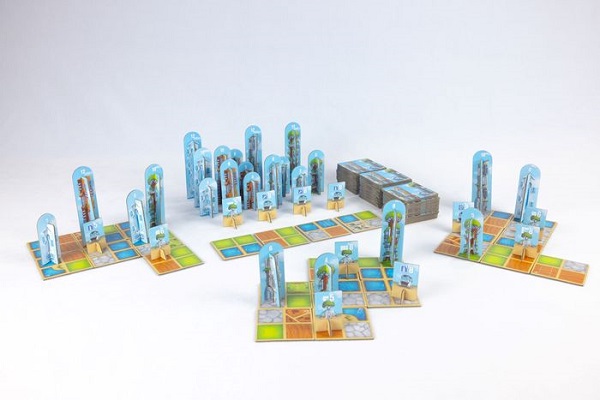Neoville: A Game of Harmonious Tile Laying

Build your city, filling it with skyscrapers and utilities. But be sure to create the perfect layout, or else those features might end up counting against your final score!
Designed by Phil Walker-Harding (Imhotep, Sushi Go!) and published by Blue Orange Games, Neoville is a tile-laying puzzle game about building nature-based cities.
Gameplay
Each player starts with a hand of three tiles. On your turn, you may add a tile to your city. Your city must fit in a four-by-four grid by the end of the game. You must place a tile so that at least one side lines up to the side of a tile already in your city. Once a tile has been placed it cannot be moved. Each tile shows four squares, and each square shows a type of terrain. There are four different terrain types in the game: water, rock, grass, and soil. A matching set of terrain types that are connected to each other are called a district. Some terrain squares will also show either a park or a sporting facility.
Next, you may take a skyscraper or utility from the supply and play it on one of the squares on your new tile. A skyscraper must be of the matching type to the terrain of the square it is placed on, and there cannot be another skyscraper already in that district. Utilities do not have these restrictions. Neither skyscrapers nor utilities may be placed on a square with a park or sport facility.
Finally, you draw a new tile to your hand, either choosing from one of the four face-up tiles on display or the top of the draw pile. It is now the next player’s turn. The game ends after sixteen rounds, when all players have completed their city grids. You then calculate your points.
Each skyscraper has a number written on it ranging from four to twelve. The number is how many points it is worth if correctly harmonized. To harmonize a skyscraper, the district it is in must be made up of a number of squares equal to or more than the number written on the skyscraper. If the skyscraper is not correctly harmonized, then it is worth negative points equal to the number written on it.
There are three types of utilities. At the start of the game you choose two types, and randomly take a certain number of that type to play with. Each type of utility has different requirements in order to harmonize them with your city. The ecomobiles will check the row and column they are in for certain features (number of parks or skyscrapers, for instance). If there is at least the required number of that feature, the ecomobile will score the points written on the token; otherwise, it will be worth negative points. Windmills must be placed on a certain location in your grid, while biodomes score if they are in a district of a certain size and shape. Finally, the player with the most parks earns five points, as does the player with the most sport facilities. Whoever has the most points wins the game.

Review
Neoville is a clever puzzle game that’s much trickier than it appears at first glance. Your early choices quickly impact your options in the later rounds, and you need to carefully consider adding skyscrapers or utilities to your city since you risk potential negative points.
Balancing bigger districts with what tiles you have available on your turn, with the utilities that are randomized at the start of each game, really brings a lot of variety to your choices and plenty of angles to consider.
There’s not much direct player interaction, but the limited number of skyscrapers and utilities in the supply is where the player interaction does come in. Do you hold off on grabbing a big scoring skyscraper until you can be sure you’ll make a district large enough for it? Or do you risk those negative points by placing it before you’re ready but before an opponent can steal it out from under you? The game does a nice job of limiting the supply enough that you do have to make those tough calls, while still giving players options on their turns.
The turns themselves are simple to learn, and the utilities do a good job of displaying the necessary scoring information on their tokens. The first time setup (assembling all the towers) is a bit long, but everything fits into the box nicely without having to take the skyscrapers apart. The game itself also looks nice. It is bright and colorful, and we liked the fact that the skyscrapers and utilities are actual 3D objects that you place on your tiles, as it makes your city more visually interesting than a simple grid of tiles would be. We particularly liked the artwork on the skyscrapers and how they come in different styles according to their terrain type.
There can be some downtime as you wait for your turn, particularly at the higher player counts, but with so many choices to consider, this time doesn’t tend to be wasted.
We quite enjoyed Neoville. It’s got a tough puzzle built into a simple ruleset that is both strategic and satisfying, while the utilities and tile draws ensure some variety between games.
Pros: Variety of the utilities used each game, limited supply works well, clever scoring system
Cons: Little direct player interaction
Disclosure: we received a complimentary review copy of this game.






